
Knowledge Hub
For refugees and internally displaced people (IDP) across the world, gardening isn’t just a way to pass the time - it is a means of survival.
According to the United Nations High Commissioner for Refugees (UNHCR), there are currently an estimated 72.1 million people who are internally displaced due to conflict or violence.
For many internally displaced people (IDP) or refugees, arriving at a camp is only the start of a difficult journey, trying to rebuild their lives in cramped shelters, often in harsh, unforgiving environments with poor sanitation, poor quality food and scarce opportunities to earn a living.
Our work with refugees and IDPs spans a number of areas, including water, sanitation and hygiene, shelter, and hunger and nutrition. Vegetable gardens are one of the ways we work towards combatting malnutrition in refugee camps. These gardens allow people to diversify their diets and improve the quality of their food, as well as with promoting other social benefits such as women’s empowerment and income generation.

However, due to challenging landscapes, limited space, unavailability of fertilisers and scarce access to water; diverse techniques and imaginative green fingers play a big part in the success of these leafy lifelines. Here are just a few of those techniques.
1. Slope gardening
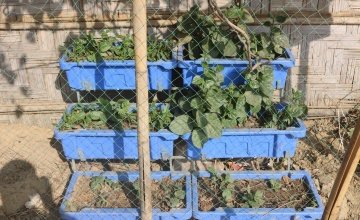
Slope gardening is a great way to maximise space – and it is pretty much what it says on the tin! Slope gardening is a technique that allows crops to be planted on a hill. Creeper plants such as cucumbers, as well as vegetables with branching roots type such as ladies fingers or aubergines are suitable for slope gardening.
The advice is that the crop should be planted and cultivated in pits and measures taken to prevent soil erosion and reduce water losses through evaporation.
2. Multilayer gardening
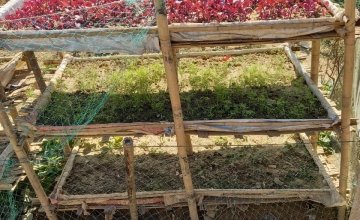
Multilayer gardening is also a great technique if you don’t have much space which is a common issue in cramped refugee camps. Essentially, multilayer gardening is the growing of compatible plants of different heights on the same field at the same time. We say ‘compatible’ because there are some vegetables that shouldn’t be planted together.
On the other hand, some plants like to grow next to each other and use each other to their advantage – for example as a support to grow over it, or as a protective base. This is the case for corn, beans and squash for example. The corn serves as a support to the bean that climbs over it, while the squash covers the ground, protecting it from moisture. Additionally, some plants climb on their own, as long as they have supports to wrap around.
In Cox’s Bazaar, Bangladesh, the largest refugee camp in the world, we recommend people use multilayer gardening to grow leafy vegetables and fruits.
3. Vertical gardening
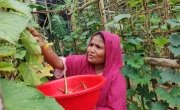
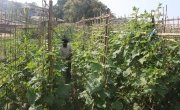

Once again, vertical gardening is rather self-explanatory (you plant vegetables vertically), and by planting upwards rather than outwards, space is maximised leaving more room for more nutritious foods to go. To create a vertical garden, a vertical structure must be installed – for example, a tree or a fence – which plants can climb up on, leaving space for other vegetables to grow underneath.
The sack and pit method is also recommended within vertical gardens, and need even less space, use water efficiently, have no soil erosion and are easily moveable. In the Rohingya Refugee camp, we work with people so they can grow sweet gourd (a type of long vegetable) which is a running or climbing vine. You do, of course, need a trellis for the vegetable to climb up onto.

With the right tools and a little guidance, communities taking part in Concern gardening projects such as these are able to increase their vegetable intake and, in some cases, earn an income.
When refugees reach camps, they don't know each other and often have to fight for a piece of land and alternative food sources. The distribution of seeds and fertilizer for vegetable gardens encourage people to instead, think collectively about space. They help build a sense of community. Many refugees in Cox's Bazar now share their seeds and crops with one another and, with a bit of technical support from Concern, are learning about vertical gardening so they can produce large amounts of vegetables in small areas.
Gardening gives individuals and families a sense of peace and purpose.
4. Macha (trellis) gardening
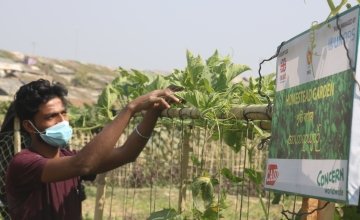
Similar to vertical gardening, trellis gardening uses the sack and pit method with a built-in trellis for the planted vegetables to grow upon. And again, in Cox’s Bazaar, we help to grow sweet gourd. However, there are many vegetables that you can grow on a trellis, from tomatoes to kale to aubergines to carrots.
While refugee camps may be born out of chaos and crisis, characterised as short-term responses with little in the way of planning for long-term living, these gardening hacks are helping some of the world’s most vulnerable people grow nutritious food, earn a living and work towards a healthier, happier and more sustainable future.
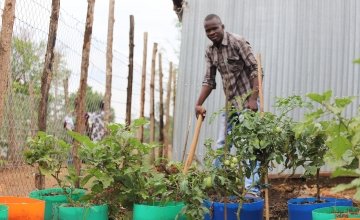
Other ways to help
Donate now
Give a one-off, or a monthly, donation today.
Join an event
From mountain trekking to marathon running, join us for one of our many exciting outdoor events!
Buy a gift
With an extensive range of alternative gifts, we have something to suit everybody.
Leave a gift in your will
Leave the world a better place with a life-changing legacy.
Become a corporate supporter
We partner with a range of organisations that share our passion and the results have been fantastic.
Create your own fundraising event
Raise money for Concern by organising your own charity fundraising event.





